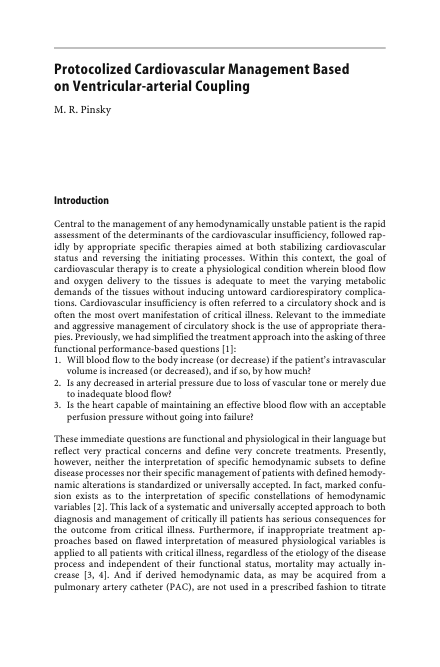Protocolized Cardiovascular Management Based on Ventricular-Arterial Coupling

- Author: M. R. Pinsky
- Full Title: Protocolized Cardiovascular Management Based on Ventricular-Arterial Coupling
- Category: #articles
- Document Tags: haemodynamics
- Summary: The text discusses how traditional measures of preload do not accurately predict preload-responsiveness in assessing cardiovascular performance. Functional methods, like physiological volume expansion trials, are suggested for better assessment. Monitoring dynamic changes in right atrial pressure, arterial pressure, and aortic flow can help predict preload responsiveness.
- URL: https://readwise.io/reader/document_raw_content/183223225
Highlights
- in severe heart failure with volume overload, increases in intrathoracic pressure will decrease left ventricular afterload and augment left ventricular ejection [28]. This will give rise to an inspiratory increase in arterial pulse pressure, the so-called reverse pulsus paradoxus (View Highlight)
- Although occasionally seen, even patients with heart failure need an effective filling pressure. Thus, iftheybecome relativelyhypovolemic then theytoo will develop aPPV. Thus, subjects with severe heart failure maymanifestPPV early ifhypovolemic and again late ifhypervolemic (View Highlight)
- even if cardiac output is supranormal, if systemic hypotension co-exists, then blood flow regula- tion and pressure-dependent flow to all organs may still be impaired (View Highlight)
- Since blood flow is phasic and not constant, elastance is a more accurate measure of arterial tone than is arterial resistance. (View Highlight)
- A perfectly coupled arterial flow circuit would have a PPV to SVV ratio close to one. However, the systemic arterial circuit usually varies flow more than pres- sure, giving the normal central arterial circuit a ventriculo-arterial coupling ratio of about 0.5. Importantly, changes in this ratio of> 20% would reflect real direc- tional similar changes in arterial tone (View Highlight)
- even if the determinants of preload- responsiveness are in doubt because of co-existing cor pulmonale or severe left ventricular failure, the relation between arterial pressure to flow is still valid. This is because the cause ofthe pulse pressure in the first place is the interaction ofthe ejected left ventricular stroke volume with the arterial impedance circuit (View Highlight)
- The degree to which MAPrises generating the arterial pulse pressure is afunction ofboth left ventricular stroke volume and arterial tone [32]. Increasing left ventricular stroke volume, all else being equal, increases MAP by a proportional amount. (View Highlight)
